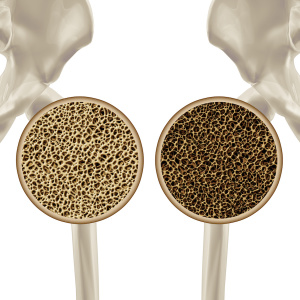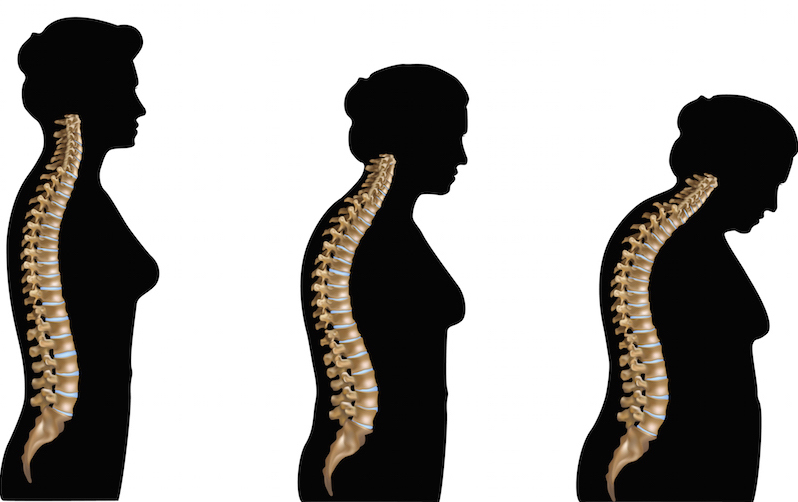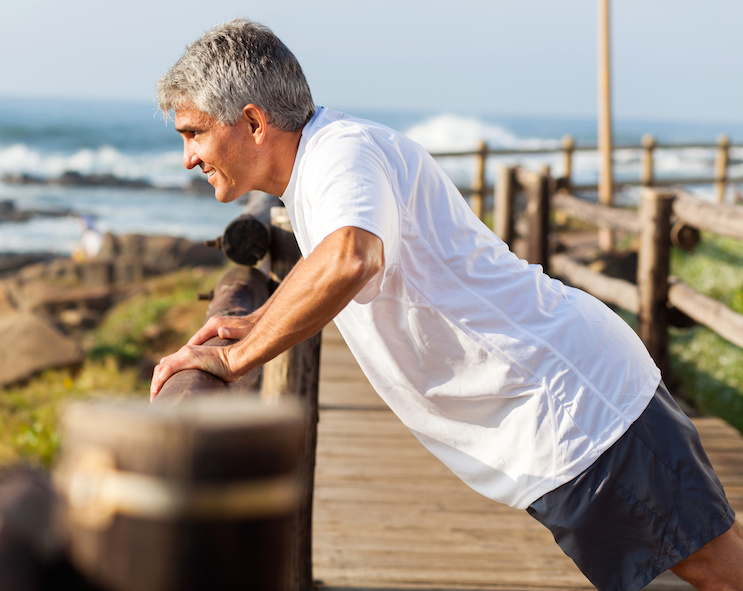
“Five years ago, I was diagnosed with osteopenia,” Allison* (alias) confides. “I was shocked.” Allison was so shocked, in fact, that she refused to believe the results of her DEXA scan, chocking the low numbers up to lab error.
But, two years later, the outcome of a second DEXA scan matched the first. “I had to accept the results as true,” Allison admits. However, Allison was still flummoxed over the diagnosis as three more years of bone scans continued to show decreasing bone density. “My vitamin D levels were consistently in the normal range, and I exercised routinely.”
Looking for a solution that didn’t involve pharmaceuticals, Allison decided to address the one element missing from her fitness regimen. “The one component my workout lacked was strength training. I just didn’t know how to approach it, and I found it intimidating.”
Allison isn’t alone. A recent survey by the Center for Disease Control found that while fifty-two percent of Americans get the recommended level of aerobic exercise (running, walking, swimming, biking, etc.), only about one in five are strength training regularly. And, while aerobic exercise may be great for improving cardiovascular health, it does little to reverse bone density loss as we age.
Strength training, however, increases bone density and can reverse the effects of osteopenia and even osteoporosis, a fact Allison happily discovered when she joined the ForeverStrong program in Fulton, MD. “After only a year and a half of working out at ForeverStrong, my last DEXA scan came back normal.”
Allison’s results aren’t unique. Study after study shows that strength training can prevent and even reverse bone density loss. So, why are so few Americans strength training on a regular basis, especially given the fact that one in two women and one in five men over the age of fifty qualify for a diagnosis of osteopenia? Is it a lack of knowledge about osteopenia? Unaware of the benefits of strength training? Or, confusion over how to manage, or prevent, bone density loss?
Likely, it’s an imperfect triad of all three, and this article seeks to clear up some of the confusion and misnomers about osteopenia and osteoporosis as well as show how a regular strength training routine can help you combat the bone loss that comes with aging.

Osteopenia Fact: “Osteopenia is not osteoporosis.”
But, osteopenia is a precursor to osteoporosis. Just like osteoporosis, osteopenia means your bone density is less than what it should be though the bone loss is not as severe as in a case of osteoporosis.
There are no outward symptoms of osteopenia, and like Allison, many people are shocked by their first bone density scans. But, osteopenia isn’t a disease; it’s a warning sign. Osteopenia provides an opportunity to reevaluate your lifestyle and help you prevent a full-blown case of osteoporosis.
Doctors recommend replacing soft drinks with green tea, consuming adequate amounts of calcium and vitamin D, and strength training. Two to three strength training sessions per week will do it. Dr. Christiane Northrup recommends working with a certified instructor to make sure you’re strength training safely and with proper form.
Allison did, and it worked wonders for her.
Osteopenia Fiction: “Medication is the best way to combat bone density loss.”
Current osteopenia and osteoporosis medications, like Fosamax, don’t exactly increase bone density, at least not in the way you’d expect. Your body produces two types of bone cells which work together to keep your skeleton healthy. Osteoclasts remove worn or damaged bone while osteoblasts create new bone to take the damaged bone’s place.
As we age, osteoclasts start working overtime, chomping up old bone faster than our osteoblasts can replace it. But, Fosamax and other bone density meds, don’t increase osteoblast production. Instead, these medications inhibit osteoclast activity. So, your bone density may technically increase, but you’re walking around on worn and damaged bone, and you’re still at a high risk for fracture.
Strength training, on the other hand, dampens osteoclast activity while boosting osteoblast productivity, especially when paired with a diet high in calcium and vitamin D. Dr. Miriam Nelson of Tufts University has conducted numerous studies that show strength training can reverse bone loss. The participants in Dr. Nelson’s studies, aged 50-70, improved their strength, lost body fat, and increased their bone density.
“It’s never too late to start exercising,” Dr. Nelson recommends. “Even in your nineties, the benefits of strength training are there. It’s quite remarkable.”
Osteopenia Fact: “Having a low body weight and lithe frame puts you at a higher risk for osteopenia and osteoporosis.”
So does being female, having fair skin, red or blond hair, and blue eyes. Genetically, the fair complected have less collagen in their bones. And, those with less body fat or lighter frames have less bone to lose.
Note to Elle Macpherson and Heidi Klum: it’s time to hit the gym.
Likewise, all you marathon fanatics and Ironmen triathletes. Don’t start thinking that the ruthless endurance routine you started in your twenties or thirties is going to keep you safe from bone loss in your fifties and sixties. Quite the opposite, in fact. All the pounding your legs took from overtraining likely created multiple minor stress fractures and impaired your bone’s ability to absorb the minerals it needs to repair itself.
Remember all those strength training days you skipped, so you could get in an extra swim, ride, or run? Turns out they were important after all. But, no worries. Starting a strength program now can get you back on track. And, if preventing bone loss is not enough to get you in the gym, strength training can also lower your marathon and triathlon times.
I have your attention now, don’t I?
Osteopenia Fiction: “Bone density loss only affects women.”

Not so fast, guys….Twenty percent of new osteopenia diagnoses are men, and one in four men over the age of fifty will break a bone due to osteoporosis. In fact, men over the age of fifty are more likely to break a bone because of osteoporosis than to be diagnosed with prostate cancer.
Yes, it’s true that estrogen loss after menopause leads to bone loss in women. Estrogen acts as a protective factor against overstimulated osteoclasts. But, guess what! Testosterone performs the same function in men, and just as estrogen levels decline with age in women, testosterone levels drop for aging men.
Lucky for men, strength training provides the same bone loss reversal benefits as it does for women. A University of Arizona study in 2009 found that men diagnosed with osteopenia who participated in a high-intensity resistance training program slowed their bone loss or, in many cases, increased their bone mineral density.
Osteopenia Fact: “A sedentary lifestyle puts you at a higher risk for bone loss.”
Admit it. As soon as I called out Elle Macpherson and Heidi Klum, you thought you were in the clear. But, if you spend the majority of your day sitting (and who doesn’t in this office-driven economy of ours), your bones are missing out on the extra workout they get from just being on your feet.
Just standing and walking around provides bones with a good weight-bearing exercise that stimulates osteoblast activity. But, if your day is anything like the average American’s, you spend an hour or so sitting in traffic and eight or so hours sitting at your desk before you spend a few hours sitting in front of the television to wind down and seven hours completely horizontal while you sleep. All-in-all, you’re spending less than four hours on your feet per day which is a recipe for osteopenia and osteoporosis later in life.
If you lead a sedentary lifestyle, it’s even more important that you incorporate strength training into your weekly routine. In fact, a study performed by Polaris Healthcare attributed the increase in men being diagnosed with osteoporosis with too much sitting and too little exercise.
Osteopenia Fiction: “Osteopenia is something only the elderly need to worry about.”
When it comes to bone density loss, prevention is the name of the game, and the healthier your bones are in your twenties, thirties, and forties, the healthier they’ll be in your fifties, sixties, and beyond. In fact, for best preventative results against bone loss, many physicians recommend beginning strength training during adolescence. Think of your bones like a retirement account. The earlier you start contributing, the bigger the payout in the end.
But, like Dr. Nelson said, it’s never too late to strength training. And, strength training is one of the most beneficial measures you can take to help prevent bone loss. Women, men, young, old, models, runners, triathletes, blonds, thin, sedentary: nobody is immune from osteopenia and osteoporosis.
Incorporating strength training now can help you prevent osteoporosis and reverse bone loss. “For five years I had repeated low bone density scans, and after only one and a half years, that has been reversed,” says a happy Allison. “The power of the program!”
Start incorporating the ForeverStrong Personalized Fitness System into your routine to prevent or even reverse bone density loss. Call us today at 301-452-5547 to schedule your free physical fitness diagnostic with Kelly Scott, creator and owner of the ForeverStrong Personalized Fitness System. Together, we can combat osteopenia and osteoporosis with an exercise program that’s right for you.